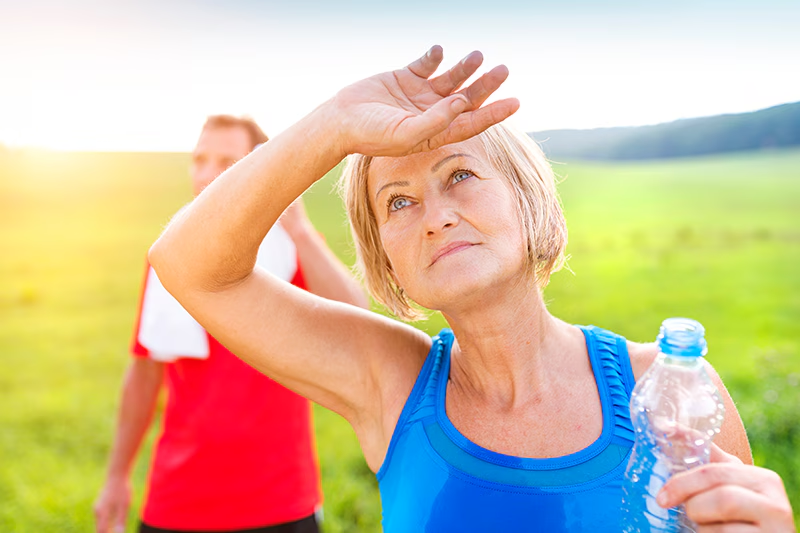GUIDE
Summer Heat and Risks of Heat Stroke

Holy moly it’s HOT!! This year’s heat has been brutal, not to mention the humidity. We’ve seen 10 days at or above 90 so far this year, and considering we still have the remainder of July and August to get through we may have a few more (Kevra). During these hot days, we should be extra aware of our bodies and what it’s trying to tell us. Water cures all, however you’ll have to do your part as well to keep yourself safe during these scorchers. I’ve heard the term Heat Stroke thrown around a lot recently, but there are other heat-related illnesses to be aware of.
Heat Rash
Typically adults develop a heat rash in skin folds like armpits, neck, and groin areas. Symptoms included small, inflamed blister-like bumps and itching or prickling in the affected area. The best way to protect yourself is to dress in loose-fitting, lightweight clothing to prevent moisture from sticking to the skin. Limiting physical activity and staying in a cool area with circulating air is recommended. (“Mayo Clinic Online”)
Sunburn
I feel this is a common occurrence, unfortunately. Caused by prolonged sun exposure to the sun, skin becomes red, warm, and sometimes painful. In extreme cases, the skin may blister. Do not break the blisters! Help relieve the discomfort by staying out of the sun and using a moisturizing lotion with aloe to soothe the burn. Prevent sunburns and help them heal by limiting outdoor activities, or if outdoors, wear proper sun protection that could include a hat and clothes that cover your skin. Tightly woven fabrics work best. When you hold the fabric up to a bright light, you shouldn’t see any light coming through. (“How to treat sunburn”)
Heat Cramps – 1st Stage of Heat Emergency
Heat cramps are painful, involuntary muscle spasms that usually occur during heavy exercise in hot environments (“Mayo Clinic Online”). This should go without saying, but STOP whatever you are doing and assess your symptoms. Drink water or a sports beverage with electrolytes and wait for the cramps to pass. If they last longer than 1 hour, you should get medical help right away (“CDC”). Dehydration and electrolyte loss a major contributors to heat cramps alongside being physically active outdoors during high humidity and temperatures.
Heat Exhaustion – 2nd Stage of Heat Emergency
Heat exhaustion begins with general muscle weakness, sudden excessive sweating, nausea, and possible fainting (“CCMH Heath”). At this point, you are feeling crappy. Get to a cool place and loosen or remove any unnecessary clothing. Take a cool bath, or soak your clothes in cool water then lay on your skin. Resist the urge to guzzle down a bottle of water, that will only upset your stomach further. Sip and swish the water until the nausea subsides. However, if your symptoms get worse, start throwing up, or persist for longer than an hour, get medical help right away. Heat exhaustion is the precursor to heat stroke and should be taken seriously.
Heat Stroke – 3rd Stage of Heat Emergency:
A heat stroke is a medical emergency. Similar symptoms to heat exhaustion but a heat stroke is when your body’s internal temperature reaches over 103 degrees (“CCMH Heath”). If you begin to experience a loss or change of consciousness, become agitated, or have unexplained behavior changes, hot, red, and dry skin, and an extreme headache, get yourself to a shaded or cool area and call 911 right away. Attempt to lower your body temperature by applying a cool compress to the head, chest, neck, and/or back, but do not drink water, especially cold water Unfortunately, water may do more harm than good by constricting the capillaries, causing stomach cramps, and decreasing the absorption rate. (“CCMH Health”)
Keep yourself and others safe during the summer heat by simply being aware of possible signs and symptoms of heat illnesses.
Works Cited
“Heat Exhaustion vs. Heat Stroke – CCMH- Lawton, Oklahoma.” Comanche County Memorial Hospital, 1 July 2020, https://www.ccmhhealth.com/heat-exhaustion-vs-heat-stroke/. Accessed 26 July 2022.
“Heat rash – Symptoms and causes.” Mayo Clinic, 6 May 2022, https://www.mayoclinic.org/diseases-conditions/heat-rash/symptoms-causes/syc-20373276. Accessed 26 July 2022.
“How to treat sunburn.” American Academy of Dermatology, https://www.aad.org/public/everyday-care/injured-skin/burns/treat-sunburn. Accessed 26 July 2022.
Kevra, Derek. “Southeast Michigan heat wave: how summer 2022 temps stack up historically.” FOX 2 Detroit, 21 July 2022, https://www.fox2detroit.com/weather/southeast-michigan-heat-wave-how-summer-2022-temps-stack-up-historically. Accessed 25 July 2022.
“Warning Signs and Symptoms of Heat-Related Illness | Natural Disasters and Severe Weather.” CDC, https://www.cdc.gov/disasters/extremeheat/warning.html. Accessed 26 July 2022.
“What Are Heat Cramps? Symptoms, Treatment, Prevention, and More.” Healthline, 9 July 2021, https://www.healthline.com/health/heat-cramps. Accessed 26 July 2022.

 BUSINESS8 months ago
BUSINESS8 months agoService Top: Understanding Role, Dynamics, and Consent in Relationships

 TECHNOLOGY7 months ago
TECHNOLOGY7 months agoSSIS 858: Everything You Need to Know

 GUIDE6 months ago
GUIDE6 months agoLookmovie2.to Legit: A Detailed Review of Safety and Features

 FASHION8 months ago
FASHION8 months agoDIY Tips to Customize Your Orange Prom Dress and Stand Out

 GUIDE7 months ago
GUIDE7 months agoTokybook: Your Gateway to the World of Audiobooks

 TECHNOLOGY7 months ago
TECHNOLOGY7 months agoUnderstanding Libgen: The Ultimate Free Ebook Library

 GUIDE8 months ago
GUIDE8 months agoLeague of Graphs: The Ultimate Guide to League of Legends Stats and Analysis

 GUIDE7 months ago
GUIDE7 months agoLook at All Those Chickens: The Story Behind the Viral Meme
















